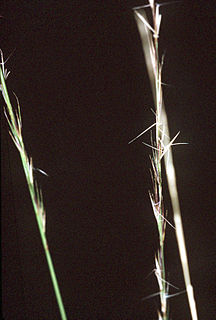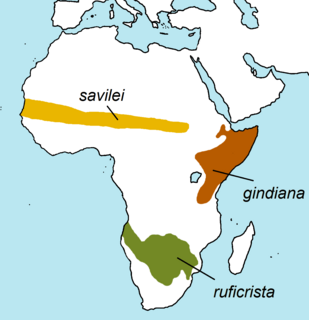
Aristida stricta is a warm-season grass, native to North America, that dominates understory vegetation in sandhills and flatwoods coastal plain ecosystems of the Carolinas in the Southeastern United States. It is known as wiregrass and pineland three-awn grass.
Yangudi Rassa National Park is a national park in Ethiopia located in Afar Region.

The frosted flatwoods salamander is a small, elongated species of mole salamander. It has a small, indistinct head, short legs, and a long, rounded tail. Typical coloration consists of a background of brownish- to purplish-black overlaid with narrow gray or silvery-white reticulations, bands, or diffuse spotting. The gilled aquatic larvae are distinctly colored, having a series of bold brown and yellow longitudinal stripes.

Aristida is a very nearly cosmopolitan genus of plants in the grass family. Aristida is distinguished by having three awns (bristles) on each lemma of each floret. The genus includes about 300 species found worldwide, often in arid warm regions. This genus is among those colloquially called three-awnswiregrasses, speargrasses and needlegrasses. The name Aristida is derived from the Latin "arista", meaning "awn".
Aristida anaclasta is a species of grass in the family Poaceae. It is found only in Yemen.

Savile's bustard is a species of bird in the family Otididae. Otididae are an Old-World and understudied family of birds mostly found in Afro-Tropical regions. It is found in Burkina Faso, Cameroon, Chad, Ivory Coast, Gambia, Mali, Mauritania, Niger, Nigeria, Senegal, and Sudan.

The Gulf Coast kangaroo rat is a species of rodent in the family Heteromyidae found in Mexico and the state of Texas in the United States. Its appearance and ecology are very similar to those of its putative sister species, Ord's kangaroo rat.

Aristida purpurea is a species of grass native to North America which is known by the common name purple three-awn.
Kalambatritra Special Reserve is a wildlife reserve in southern Madagascar. It is to the north of Andohahela National Park, south-west of the Manombo Special Reserve and contains many endemic species, including forty-five endemic bird species.

Aristida californica is a species of grass known by the common names California threeawn and Mojave threeawn. It is native to the Mojave Deserts and Sonoran of northern Mexico and California and Arizona.
Aristida portoricensis is a rare species of grass known by the common name pelos del diablo. It is endemic to Puerto Rico, where it is known from two locations, one in a residential area of Mayagüez and one in the Sierra Bermeja. Two other known sites have been extirpated by development of the habitat. It is a federally listed endangered species of the United States.

Quercus incana is a species of oak known by the common names bluejack oak, upland willow oak, sandjack oak, and cinnamon oak. It is native to the Atlantic and Gulf coastal plains of the United States, from Virginia around Florida to Texas and inland to Oklahoma and Arkansas.
Grevillea phanerophlebia, commonly known as the prominent vein grevillea and the vein leaf grevillea, is a shrub of the genus Grevillea native to a small area on the west coast in the Mid West region of Western Australia.

Aristida tuberculosa, common names seaside threeawn, seabeach needlegrass, beach three-awned grass and beach needlegrass, is annual plant native to the United States.

Aristida longespica is a species of grass known by the common name slimspike threeawn. Aristida longespica var. geniculata is listed as a species of special concern in the State of Connecticut.

Aristida rufescens is a grass species native to Madagascar and to Mayotte in the Comoros archipelago. It was described by German agrostologist Ernst Gottlieb von Steudel in 1854.
Aristida dichotoma, known as churchmouse threeawn, fork-tip three-awn, pigbutt three-awn, and poverty grass, is a species of grass from eastern North America. It is native to the Eastern and Midwestern United States and Ontario, Canada. It has been introduced in California. It was described in 1803 by André Michaux.

Aristida contorta, commonly known as bunched kerosene grass, kerosene grass, bunched windgrass, silvergrass, mulga grass,sand speargrass, and medicine grass, is a species of grass in the family Poaceae that is native in Australia. The Walmajarri name for this species is Ngirrirli.

Aristida acuta is a native Australian species of grass. Found in New South Wales and Queensland.













